Bunion Surgery
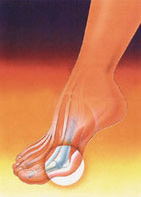
Most bunions can be treated without surgery. But when nonsurgical treatments are not enough, surgery can relieve your pain, correct any related foot deformity, and help you resume your normal activities. An orthopaedic surgeon can help you decide if surgery is the best option for you. Whether you've just begun exploring treatment for bunions or have already decided with your orthopaedic surgeon to have surgery, this booklet will help you understand more about this valuable procedure.

What is A Bunion?
A bunion is one problem that can develop due to hallux valgus, a foot deformity. The term "hallux valgus" is Latin and means a turning outward (valgus) of the big toe (hallux). The bone which joins the big toe, the first metatarsal, becomes prominent on the inner border of the foot. This bump is the bunion and is made up of bone and soft tissue.
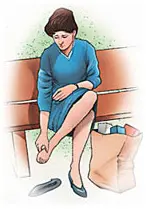
What Causes Bunions?
By far the most common cause of bunions is the prolonged wearing of poorly fitting shoes, usually shoes with a narrow, pointed toe box that squeezes the toes into an unnatural position. Bunions also may be caused by arthritis or polio. Heredity often plays a role in bunion formation. But these causes account for only a small percentage of bunions.
A study by the American Orthopaedic Foot and Ankle Society found that 88 percent of women in the U.S. wear shoes that are too small and 55 percent have bunions. Not surprisingly, bunions are nine times more common in women than men.
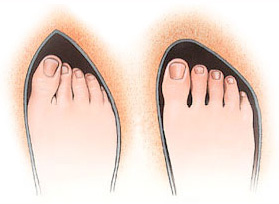
Can Bunions Be Prevented?
Bunions often become painful if they are allowed to progress. But not all bunions progress. Many bunion problems can be managed without surgery. In general, bunions that are not painful do not need surgical correction. For this reason, orthopaedic surgeons do not recommend "preventive" surgery for bunions that do not hurt; with proper preventive care, they may never become a problem.
Bunion pain can be successfully managed in the vast majority of cases by switching to shoes that fit properly and don't compress the toes. Your orthopaedic surgeon can give you more information about proper shoe fit and the types of shoes that would be best for you.
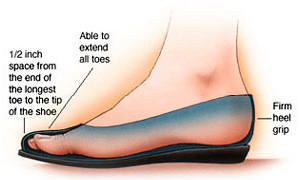
Follow these general points of shoe fit:
- Do not select shoes by the size marked inside the shoe. Sizes vary among shoe brands and styles. Judge the shoe by how it fits on your foot.
- Select a shoe that conforms as nearly as possible to the shape of your foot.
- Have your feet measured regularly. The size of your feet change as you grow older.
- Have both feet measured. Most people have one foot larger than the other. Fit to the largest foot.
- Fit at the end of the day when your feet are the largest.
- Stand during the fitting process and check that there is adequate space (3/8" to 1/2") for your longest toe at the end of each shoe.
- Make sure the ball of your foot fits well into the widest part (ball pocket) of the shoe.
- Do not purchase shoes that feel too tight, expecting them to "stretch" to fit.
- Your heel should fit comfortably in the shoe with a minimum amount of slippage.
- Walk in the shoe to make sure it fits and feels right. (Fashionable shoes can be comfortable.)
Some shoes can be modified by stretching the areas that put pressure on your toes. Splints to reposition the big toe and orthotics (special shoe inserts shaped to your feet) also may relieve pain. For bunions caused by arthritis, medications can be prescribed to reduce pain and swelling.
Is Bunion Surgery for you?
If nonsurgical treatment fails, you may want to consider surgery. Many studies have found that 85 to 90 percent of patients who undergo bunion surgery are satisfied with the results.
- Severe foot pain that limits your everyday activities, including walking and wearing reasonable shoes. You may find it hard to walk more than a few blocks (even in athletic shoes) without significant pain.
- Chronic big toe inflammation and swelling that doesn't improve with rest or medications.
- Toe deformity-a drifting in of your big toe toward the small toes.
- Toe stiffness-inability to bend and straighten your toe.
- Failure to obtain pain relief from nonsteroidal anti-inflammatory drugs. Their effectiveness in controlling toe pain varies greatly from person to person.
- Failure to substantially improve with other treatments such as a change in shoes and anti-inflammatory medication.
As you explore bunion surgery, be aware that so-called "simple" or "minimal" surgical procedures are often inadequate "quick fixes" that can do more harm than good. And beware of unrealistic claims that surgery can give you a "perfect" foot. The goal of surgery is to relieve as much pain, and correct as much deformity as is realistically possible. It is not meant to be cosmetic.
Types of Bunion Surgery
- Repair of the Tendons and Ligaments Around the Big Toe
- Arthrodesis
- Exostectomy
- Resection Arthroplasty
- Osteotomy
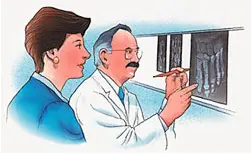
Your orthopaedic surgeon will review the results of your evaluation with you and discuss whether surgery would be the best method to relieve your pain and deformity. Nonsurgical options, including switching to different shoes, also will be discussed. Your orthopaedic surgeon also will explain the potential risks and complications of bunion surgery at this time.
|
Realistic Expectations About Bunion Surgery
An important factor in deciding whether to have bunion surgery is understanding what the procedure can and can not do. The vast majority of patients who undergo bunion surgery experience a dramatic reduction of foot pain after surgery, along with a significant improvement in the alignment of their big toe.
Bunion surgery will not allow you to wear a smaller shoe size or narrow-pointed shoes. In fact, you will have some shoe restrictions for the rest of your life. Always follow the recommendations for shoe fit presented in this booklet.
Remember that the main cause of the bunion deformity is a tight fitting shoe. If you return to that type of shoe wear, your bunion will reappear.

Preparing for Surgery
If you decide to have bunion surgery, you may be asked to have a complete physical with your family physician before surgery to assess your health. If you have heart or lung conditions or other chronic illnesses, you will need a preoperative medical clearance from your family physician.
Before surgery, tell your orthopaedic surgeon about the medications you are taking. He or she will tell you which medications you should and should not stop taking before surgery.
Tests, including blood samples, a cardiogram, a chest X-ray, a urine sample, and special foot X-rays, may be ordered by your orthopaedic surgeon to help him or her plan your procedure.
Your Surgery
Almost all bunion surgery is done on an outpatient basis. You will most likely be asked to arrive at the hospital or surgical center one or two hours prior to surgery.
After admission, you will be evaluated by a member of the anesthesia team. Most bunion surgery is performed under ankle block anesthesia, in which your foot is numb, but you are awake. General or spinal anesthesia is used occasionally. The anesthesiologist will stay with you throughout the procedure to administer other medications, if necessary, and to make sure you are comfortable.
The surgery takes about one hour. Afterwards, you will be moved to the recovery room. You will be ready to go home in one or two hours.
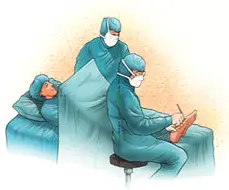
Possible Complications After Surgery
Fewer than 10 percent of patients experience complications from bunion surgery. Possible complications can include infection, recurrence of the bunion, nerve damage, and continued pain.
If complications occur, they are treatable but may affect the extent of your full recovery. Your orthopaedic surgeon will explain various options in treating these complications.
Your Recovery at Home
The success of your surgery will depend in large part on how well you follow your orthopaedic surgeon's instructions at home during the first few weeks after surgery. You will see your surgeon regularly for the next several months to make sure your foot heals properly.
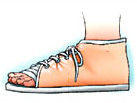
Dressing Care
You will be discharged from the hospital with bandages holding your toe in its corrected position. You also will wear a special postoperative surgical shoe or cast to protect your foot. Your sutures will be removed about two weeks after surgery, but your foot will require continued support from dressings or a brace for six to eight weeks. To ensure proper healing, it is very important not to disturb your dressings and to keep them dry. Interference with proper healing could cause a recurrence of the bunion. Be sure to place a plastic bag over your foot while showering.
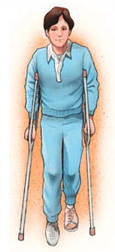
Bearing Weight
Your orthopaedic surgeon may advise you to use a walker, cane, or crutches for the first few days after surgery. You can gradually put more weight on your foot as your wound heals. However, walk only short distances during the first few weeks following surgery. You will probably be able to drive again within about a week.
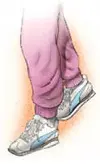
Swelling and Shoe Wear
Keep your foot elevated as much as possible for the first few days after surgery, and apply ice as recommended by your orthopaedic surgeon to relieve swelling and pain. You will have some swelling in your foot for about six months. After your dressings have been removed, wear only athletic shoes or soft leather oxford type shoes for the first several months until the surgery has completely healed. Do not wear fashion shoes, including high heels, until after six months. Follow the tips on shoe fit presented earlier in this booklet when selecting your shoes. This will help prevent the recurrence of your bunion.
Exercises to Strengthen Your Foot
Some exercises or physical therapy may be recommended to restore your foot's strength and range of motion after your surgery. Your surgeon may recommend exercises using a surgical band to strengthen your ankle or marbles to restore motion in your toes. Always start these exercises slowly and follow your surgeon's or physical therapist's instructions regarding repetitions.
Medication
Your orthopaedic surgeon may prescribe antibiotics to prevent infection for several days after your surgery. Pain medication to relieve surgical discomfort also will be prescribed for several days.
Avoiding Problems After Surgery
Though uncommon, complications can occur following bunion surgery. Contact your orthopaedic surgeon if:
- Your dressing loosens, comes off or gets wet.
- Your dressing is moistened with blood or drainage.
- You develop side effects from postoperative medications.
Also, call your orthopaedic surgeon immediately if you notice any of the following warning signs of infection:
- Fever
- Chills
- Persistent warmth or redness around the dressing
- Increased or persistent pain.
- Significant swelling in the calf above the treated foot
Your orthopaedic surgeon is a medical doctor with extensive training in the diagnosis and nonsurgical and surgical treatment of the musculoskeletal system, including bones, joints, ligaments, tendons, muscles, and nerves.
This brochure has been prepared by the American Academy of Orthopaedic Surgeons and is intended to contain current information on the subject from recognized authorities. However, it does not represent official policy of the Academy and its text should not be construed as excluding other acceptable viewpoints. Persons with questions about a medical condition should consult a physician who is informed about the condition and the various modes of treatment available